Archive for the ‘#flyfishingformula’ Tag
Feel Your Way…….
Hidy Ho Good Neighbors,
So, have you tried Euro style nymphing yet? I know, sounds funny coming from a guy that wrote a book about the systematic approach to nymphing, but I have done a fair amount of this technique over the last couple of years. Even have my clients working a modified euro system on pretty much every guide trip.
Now, I’m no expert on euro style, but I appear to be qualified enough to talk about it because my clients catch plenty of fish, even on the first time out, using my quirky method. I tagged my method “eurorado nymphing” because it includes Colorado nymphing methods coupled with euro-style principles. I’ve included a section in my latest book, Hidden in Plain View, that goes into greater depth on what I do.

A good stocking stuffer
Suspended nymphing under an indicator still has a place in my arsenal as it can create longer more consistent drifts, gives you the ability to work water that is more than a couple rod lengths away, and gives you the ability to see fish eats thru the indicator. However, the ability to work the upper half of a drift effectively while dialing in drift speeds is a bit tougher under an indicator. Think back to the last time you nymph fished, how many fish did you catch upstream of the halfway point of your drift? Exactly, it’s hard to recall because it just doesn’t happen as often as the fish you catch from the middle to end of the nymph drift. That’s because that is when most anglers have the depth and speed finally perfect.
Eurorado style, on the other hand, allows you to work the upper part of the drift well. It allows you to feel working over obstructions, shelves and bars. And, you catch the majority of the fish above the middle point of your drift, because you get the bugs down quickly, and dial in depth and speed quickly after your bugs hit the water. Each method has its merits, but like I always say, the more versatile an angler you are, the more you’ll enjoy the sport.
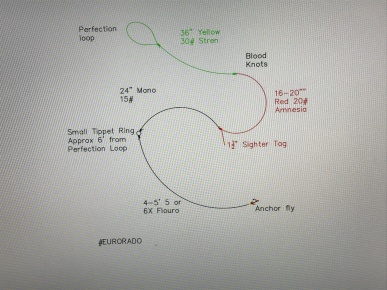
Customize as needed
Some days Eurorado nymphing is like a vacuum, picking up fish in a river where suspended nymphing wouldn’t be able to and it’s relatively easy to rig and learn. Again, I’m no expert, but there are many videos available that can get you started. As for gear, I run a 10’6” 3 weight Master Nymph Bellator fly rod with a matching Lamson Liquid reel. This rig is balanced and light weight with incredible accuracy and fish fighting capabilities. I also employ a sighter-leader of my design and use bugs of my design.
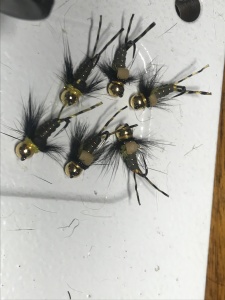
A gaggle of Booby Traps
The sighter-leader and flies used is where I put the “rado” in this rig, because it smacks of Colorado nymphing. Most Euro-style leaders are around twenty feet (and longer) lengths, whereas my leader is around eleven feet long. It is comprised of several different sections of monofilament, fluorocarbon, and amnesia lines, with a sighter tag and tippet ring thrown in for a cause (see pic). As for my bugs, I run a weighted Booby Trap, as my anchor, and run in-line off of that. So, off the bend of the Booby Trap, I run tippet to a DP643 which is an unweighted soft hackle, and off of that bend I run a Butt Crack Baetis (unweighted) in the appropriate size and color. I’m sure you can see the indicator nymphing influence here.
This rig has served me and my clients well over the last couple of years on the Eagle River, and it can easily be customized to your favorite water with a little thought and tinkering. I continue to learn a bit more each time my boots get wet, but I am sold on this technique. I really enjoy the simplicity, ability to feel your way along a river bottom, and the consistency to get depths and speeds dialed in quickly on every drift.
That’s my story and I’m sticking to it…….Fear No Water!
Happy Holidays!
Hidy Ho Good Neighbors,
I pulled on the zipper for the last time as the fabric separated from the zipper and the zipper slide became lodged on the teeth. This is quite disconcerting as you’re knee deep in the river with no way to ensure your fly boxes aren’t going to become refugees. I hadn’t put more than one hundred guide trips on the waist pack I had and it was not showing the durability of previous gear from this manufacturer. Right then and there I decided to look into a different company to supply me another waist pack.
I’ve dealt with Umpqua gear in the past and was always satisfied with their performance and durability. My Tongass pack has never let me down as I have traveled the country with it, floated down several rivers, and even went for a few unplanned dips in the water with it on my back. Each instance, the pack has answered the durability bell and kept my expensive camera gear bone dry. I chose the Umpqua Ledges 650 waist pack in hopes that it would perform equally as well.
I just completed my sixtieth guide trip with the new pack and I like it very much. Every piece of gear in my old waist pack fit nicely in the Ledges 650 and left space for more gear than I typically carry. The large compartment has a leaf installed that helps keep your boxes separate and organized. Boxes slide in and out without issue. The pack is very comfortable to wear as the wide hip belt and shoulder straps are well padded and ergonomically justified. I especially like the plastic plate between where your hip and the bag meet. This allows the pack to freely slide around your torso without catching your waders and coming to a quick halt. This feature also provides a space between the pack and angler that keeps one from overheating on those hot summer afternoons.
The fabric is very durable, well stitched, and for what it’s worth, I like the color patterns. The zippers, ahh the zippers, my usual nemesis, have worked unerringly. The zippers are incredibly hard core, over-sized, and the pulls are reinforced, dipped, and will take a pretty good tug over and over again. Point blank durability at its finest.
Speaking of zippers, I do have a slight issue with the placement of the main compartment zipper. I have found it difficult at times to open or close that compartment because the zippers are in close proximity to my body and it’s tough to get the zipper started as you open or close the compartment. My opinion is that in the next generation, the designers may want to look at moving that zipper to the front of the bag. It’s not a show-stopper for me; it’s just that everything else with this pack is perfect, why not this too?
There are a couple of sleeper amenities on this pack that are worth their weight in gold. In the front there’s a great slot to carry forceps. I carry two spares in there. Also, under the used fly pad, there’s a neat compartment for whatever where I carry my thermometer, and below that is a zippered pocket where I carry extra leaders and my phone. I really like the compartments on the belt straps; I carry my weights, dry shake, extra lighter, and a fly puck in those. The front elastic pockets are a handy “get-to-fast” feature, and the compartments behind those are hard to overfill with tippet, pucks, or a cigar or two. This pack just has it going on.
Overall, I give this pack a very high rating, and I have only had it a third of a season. I expect it to age gracefully and keep me well supplied and comfortable for its entire life. Thanks Umpqua, for another fine piece of fly fishing gear.
Fear No Water!
Duane
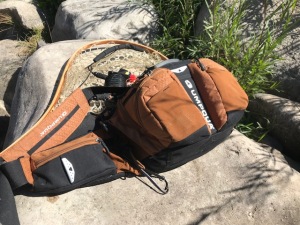

Of Redds and Run-off
Every year I hear the same old crap about folks ripping spawning fish off Redds. Drives me crazy, infuriates me really. How can you interrupt something as sacred as spawning fish? That’s our guarantee for future fishing, and there ain’t nothing wrong with wild fish, or the fish helping out in the quest for more fish. Our respective game and fish departments can’t do it all.
Maybe some folks just don’t know what to look for, so here goes: look for water up to about thirty inches deep with areas that looked like they’ve been swept with a broom. Usually, this is a flatter section of the river, with slower moving water. Also, look for one or more fish sitting atop this swept out area. I’ve seen redds the size of a coffee table, up to the size of an auditorium. Both are equally easy to spot if you’re paying attention.
You may be thinking, “So where do I fish then?” The answer is simple, “Not on the redd, but above or below it.” Target the species not spawning on the shelves and pools below spawning fish. Hmmmmm, wonder what patterns to throw…You can certainly toss egg patterns in your nymph rigs and follow that up with the fly of the day, or the dominant hatching insect. No mystery, really, just do your best to be observant, step around the redds, and fish anywhere but on them.
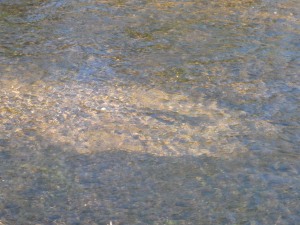
Pretty dang obvious Redd. Just observe.
Run-off is bearing down on us as the water rises and goes off color. My day usually starts out nymphing two and three bug rigs under an indicator, using darker and sparser bugs. I like weighted flies (odd for me, but conditions call for it), with dark and sparse materials, to get the bugs down quickly and allow the fish to readily see them. The darker colors are easier for fish to see in off-color water. I tie my favorite flies in black, purple, red, and even throw in some true fluorescent orange and pink collars to provide for “hot-spots” and visibility.
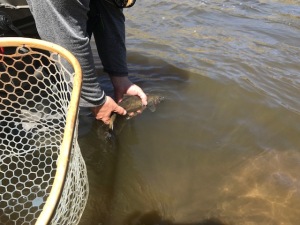
Little dirt in the drink.
Lately, my days have been ending throwing the mini-rig (it’s in the book), with a black Chubby Chernobyl followed by a black soft hackle (DP643), and a size 18 purple Butt Crack Baetis. Killer. The fish are moving to the edges and up into the riffles (not redds) to consume baetis swimmers and emergers, and the occasional skwala stones and migdes. You’ve all heard me preach about carrying two rigged rods, well this time of year is perfect for it. So, mornings I work bottom up, afternoons, top down.
Don’t hesitate to rip streamers as the water’s rising, that can be as productive as it is fun. I like to run tandem rigs with a white or lightly colored streamer up front, followed by a Slumpbuster or similar 20# below on 2 or 3 X tippet. I like to tie a loop knot to the trailing streamer to allow for a bit more movement. Typically, I’ll run a five to six foot tapered leader down to 2 or 3X to my first streamer, tie off the bend with the same to my terminal meat. If you’re not moving fish, you’re probably above their level, so employ more weight, casting angles, or mending techniques to get those streamers deeper. Vary your retrieves, strip set, and hang on.
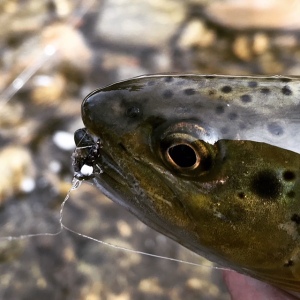
Black soft-hackles during run-off
As we get into full-blown chaos with run-off, focus on the banks, edges, eddy’s, and sleeper seams out from the banks. Just be damn careful stepping into crazy water. Dress appropriately, use a wading staff, take a friend, and show discretion and common sense. It’s not worth dying for.
A few nymphs to consider for run-off:
Black Pat’s Rubberlegs
Black Leeches
Cranefly Larva
Black Soft-Hackles (#16-18)
Purple Butt Crack Baetis (#18)
Purple, Pink or Red San Juan Worm
Various Egg patterns
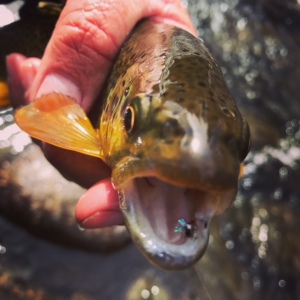
Purple Butt Crack Baetis
Fear No Water…except during run-off
Hidy Ho Good Neighbors,
I feel like I beat this subject to death, but it’s that important. Heck, it’s critical to fly fishing success. Whether your nymphing, dry-dropping, mini-rigging, skinny rigging, or dry fly fishing, keeping those flies flowing like the naturals in the Y seam to positioned fish is a skill to master.
Think of drinking your latte this morning, your mug went directly to your mug! In other words, you didn’t have to think twice about the path to your mouth, nor did you have to move to collide with the cup. It flowed to your mouth naturally. I contend, that if feeding fish have to move to eat your flies that are drifting unnaturally in the current, they will most often pass yours up to eat the naturals that are flowing perfectly. Fish see thousands of natural bugs drifting in the currents every day, if you can’t match that drift, you’re in for long days.
The Y seam is rarely if ever a straight line, it’s usually drifting to or away from you. Often it’s a combination of both, and fish set-up in advantageous spots, that make feeding on “real” bugs almost effortless. Don’t make them work for a meal. Strive to stay at proper depths and speeds as you stay in the Y seam.
I have uploaded a video for you to watch at: https://youtu.be/Up8EUzO0RxM
As always, find this and more explained in my latest book, Hidden in Plain View (Amazon)
Hit me with questions and comments, share the video with your fishing buddies, and Fear No Water!
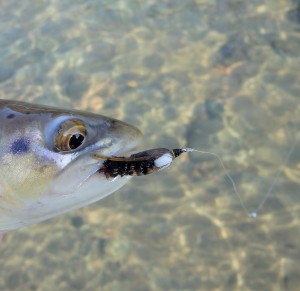
Directly to this face! Master the Y seam drift!
Hidy Ho Good Neighbors,
Once again, the speaking circuit is up and running. Just got back from Atlanta, and getting ready to head to Texas for the GRTU Troutfest. In between, I will have a couple chances to get on the water, tie a few bugs, and tighten up my speaking game. It’s a whole different world this time of year.
Buzzing around the country talking with so many anglers is quite humbling and extra enjoyable. I sat with Lincoln Westby (look him up if you don’t know who he is) for two full days last week at the Atlanta show, just picking his brain. At seventy plus years of age he is still incredibly passionate about this sport. I was humbled and truly thankful for that opportunity, plus I picked up more than a few tips. I bump into all kinds of people that teach me loads simply by the questions they ask. Many times, I have to stop and think on their question, which forces me to make ask them questions, make choices, clarify, or quantify a stance on a particular subject. Doing this tends to sharpen ones focus, and steel ones opinions.
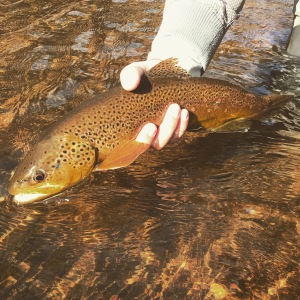
@rodcuffs releasing a South Platte Brownie
Once I begin to sharpen focus on a subject then I begin to dig into my reasoning for believing one way or another, and every now and then, I change my stance on a previously held thought. Sometimes, however, I stop, cock my head to one side and think, “Nope, not going to believe that.”
At a show last year, I was walking by the casting pool as someone was presenting to a group of anglers. This presenter was talking about setting the hook techniques, and had the fly rod pointing down to the opposite end of the pool as the point was made. With line out in the pool, and a large management loop formed from the index finger on the cork, this person proceeded to explain a dry fly set. “Reach up here with your left hand, grab the fly line up here above the cork, and pull hard to the side as fast as possible.” I stopped in mid stride at the edge of the pool just to confirm what I thought I heard. Yup, that’s what I heard.
So, in front of your management loop, you reach up with your off-hand grabbing the fly line and pulling to the side for the set. This alignment renders your loop worthless. What if you happen to hook the fish? Then, you’d have to take the line in your off hand and put it back under your index finger on the cork, just to begin to fight the fish. This is as hard to explain as it is to be believe. So, imagine you’re holding the fly rod in your right hand, and the management loop is created between your index finger on the cork and the fly reel. See it? Now, a fish eats so you need to set. Take your left hand and reach above your cork hand (toward the fly rod tip), and grab the fly line between the first line guide and the cork, above your hand. Pull it tight, out to the side, quickly.
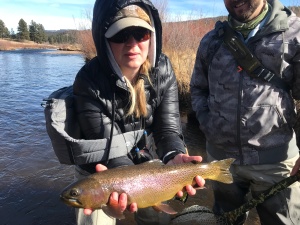
Nice winter fish for this sweet lady
I don’t get it. Usually when I hear something like that I can find some merit, or reasoning. I am still stumped many months after hearing this, and have shared this story with many in hopes someone could enlighten me. Not being a jerk here, but honestly trying to figure out what I am missing, because I just might learn something. Shoot me a note with any theories. You can’t ask a stupid question here, or give a stupid response, it’s all about learning.
The Eagle River has some shelf ice up high, and downstream you’ll find smaller amounts. The lower river has been checking in at about 38 degrees at ten in the morning, and warms up to about 41 degree on full sun days. Midges are coming off, and I (and the fish) are already beginning to look for Blue-Winged Olives. Not a bad idea to throw a pink San Juan, Black Soft Hackled PT, and a Buttcrack Baetis in that order, if you’re so inclined. Other combinations will work equally as well as long as depth and speed are dialed in. Go low and slow.
The latest book (Hidden in Plain View) is still doing well. Thanks again everyone.
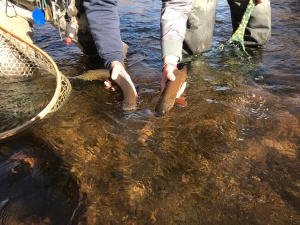
Sweet release times two….
Fear No Water!
Duane
Hidy Ho Good Neighbors,
I’ve heard it said, “If you’re the smartest guy in the room, you’re in the wrong room”. I certainly not only subscribe to that notion, but find it easy to not be the smartest guy in the room.
Recently, I had the opportunity to be a featured author at a book signing at the Blue Quill Angler in Evergreen Colorado. This was not your normal book signing, not when you’re elbow to elbow with John Gierach, Pat Dorsey, Ed Engle, Landon Mayer, Marty Bartholomew, Steve Schweitzer, David McElwain, and Terry Grosz. Nope, this was something special for me and I was humbled and excited to be counted in the fold.
There are many ways to learn new skills, tactics, techniques, or perceptions about any endeavor. Most folks learn
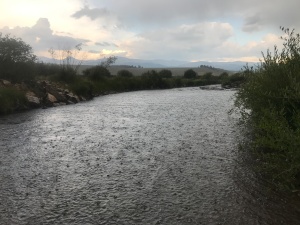
Wasn’t the smartest in the room this day….Lightening and hail in the high country and it’s me and my 6’5″ client…..
best by seeing or doing, while the rest learn by reading or study, and it’s always easier to learn from someone that already knows what you want to learn (think back to 7th grade Spanish class). Therefore, when I’m in the situation where I am surrounded by tons of knowledge, I keep my mouth shut and listen, listen, listen. I still have so much to learn about fly fishing.
I’ve been guiding a long time, before that, I taught school for 22 years, and I feel as if I have a pretty good handle on how to break things down, present them in bite-sized pieces and feed them to hungry learners. I had great mentors that taught me the “teaching ropes” and that hastened the process. Still, after 22 years, I wasn’t the smartest in the room, but was still the hungriest. Hungry to learn, learning by listening and watching, followed by a healthy dose of “go do”.
I consider myself a life-long learner, and I realize I have a long way to go when it comes to mastering what I do, but that doesn’t stop the journey. This year, I’ll be presenting to folks all across this country, a brand new fly fishing presentation. I try to create a new one each year, to keep things fresh for me and my audiences. Do I know everything? Not in the least, but I do know this, the more I teach, the more I learn. More often than not, I come away from an evening presentation with more questions bouncing around in my head. Stuff I can only answer by getting on the river.
During the slower months of winter, when I guide sparingly, I often look to put a bit of time into fishing. Funny thing is, I never go just to catch fish. I’m always working on or testing something. I may be testing a rig wrinkle, bug stage modification, a specific drift mechanic, or a modified piece of equipment, but I always fish with a purpose other than trying to just put fish in the net. Often, I am fishing with folks that are nailing fish, but I keep testing, pushing the envelope, and trying to learn, while watching fish after fish hit the bottoms of their nets. It takes discipline and a pile of hard-headed stubbornness to not just blow-off what I’m doing and simply fish, but I remain steadfast in my mission.
I’m always looking for a new perspective, or a subject that receives too little attention, maybe a newly recognized (to me) cause and effect, or something that I consider obscure by the standards that I guide and fish to. Ultimately, I try to pass what I learn onto the folks that I guide, that read my books, or that see my presentations. It’s worth it.
This years’ presentation is titled: The Dance, Landing Trout on a Fly Rod. I’ve been thinking about this presentation for years, because everyone talks about everything from the cast to the drift, and the set, even how to take photos, but actual discussion of fish landing techniques and rod physics is rarely broached. Gonna’ change that. I truly hope folks will like it.
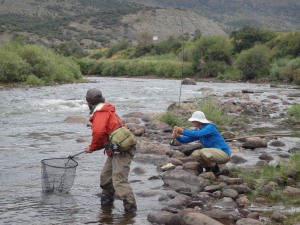
The Dance
Hidden in Plain View is doing great. Thanks to those of you that have purchased the book. Proud to say it’s still in the top 10 of new fishing releases through Amazon after 3 weeks in. Pretty humbling for sure.
So, you see, that extra work, the little touch of stubbornness (depends on whom you talk to), and the ability to listen while realizing you’re not the smartest in the room, is worth it in the long run. Hopefully, at the next show, event, or club gathering, you and I get a chance to talk, I always welcome the opportunity to learn new things.
Fear No Water!
ps. the new speaking schedule is up.
Pss. There’s still time to purchase a copy of the book before Christmas (Amazon/Barnes and Noble)
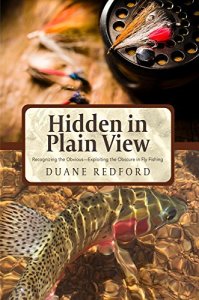
Still time!
Hidy Ho Good Neighbors!
Added a new video at: https://youtu.be/h_8BmcfsYnQ

Obligatory grip and grin…
This one deals with fishing those juicy shelves you find in every river. Not all shelves look the same. Most are very easy to locate at the lateral top of a run, some are hidden within the run and some run longitudinally with the run. If you look closely at the video thru the link I provided, you will see a fast riffle dumping over the shelf. Look closer and you will see “sleeper seams” within the run as it dumps over the shelf. Sleeper seams show nearly imperceptible areas where obstructions gently slow the river flow. Almost a sure thing that you’ll find feeding fish holding in those sleepers, and the adjoining seams, but you’ve really got to stop and look closely.
The trick is to cast up onto the fast water to place your bugs above the shelf and put them in perfect position as the water slows and drops onto the shelf. If fish are up there, they are there to eat. Make sure you’re mended up, anticipating the next mend, and primed to set quickly. Adjust your rig longer and heavier than you think you’ll need because you want your flies to follow the same path as the naturals. If you’re too light or too short, your flies will rarely drop into the proper column as the fish are below the fast water, because they are sitting in the slower flows down on the shelf. Once you really concentrate on mastering a few shelves, the formula becomes easy to figure.
Sometimes you’ll see where a lateral, across the river shelf, and a longitudinal, with the river shelf connect. That situation can be pure magic as it provides multiple areas where food and fish will collide. That’s the crux of the Fly Fishing Formula. You want the fish to either eat or get out of the way. Opportunistic feeding fish will move distances to eat, selectively feeding fish will either eat or sway out of the way. They are more prone to eat if your drift is perfect and your flies are close to the naturals in size and color. Make the fish decide.
Enjoy the video. Go work a shelf as soon as possible and get back to me!
Fear No Water

















